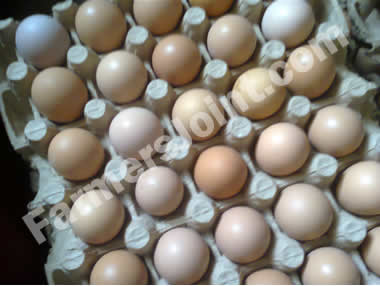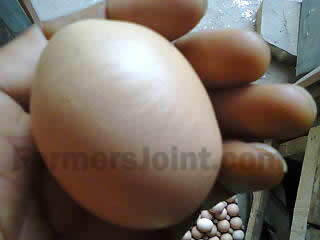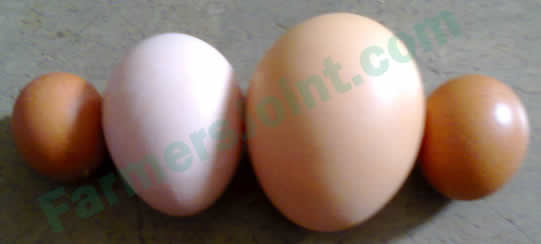 We’re used to normal eggs but when we encounter some abnormal ones, we may start wondering how safe they are for consumption, or we may wonder how and why it really happened. Below are answers to some common questions about egg layers and abnormal eggs.
We’re used to normal eggs but when we encounter some abnormal ones, we may start wondering how safe they are for consumption, or we may wonder how and why it really happened. Below are answers to some common questions about egg layers and abnormal eggs.
#1. Egg Shells with Rough Patches and/or Little Hard Pimples
The rough patches or hard pimples you see are due to deposition of excess calcium on the shell. It can happen due to the following reasons.
- Young hens laying for the first time may produce such eggs but after a while it cease.
- It can also occur in older birds when they are getting excess calcium. For example, during the winter when egg production slows down, some eggs might get more calcium deposited on them. You can counter this by stimulating egg production with light and by feeding balanced feed or high-protein treats if you don’t feed your birds commercial feed.
- Water shortage can also cause layers to lay eggs with rough patches and hard pimples. If there is water shortage, the egg will be delayed for a while in the reproductive tract of the bird, causing it to accumulate excess calcium on the shell.
- When birds are scared by a predator, very loud storms etc, the same issue can occur. Disturbances can cause the birds to stop laying for some days and when they finally resume laying, their first eggs may be misshapen, shell-less or with very rough shells.
Eggs with this flaw are safe to eat.
#2. Eggs with Ridges or Grooves on the Shell
Such eggs are called body checked eggs. The ridges and grooves usually occur at the pointed end but can also occur at the other end and at the middle of the egg. It is caused when the shell gets damaged due to stress or pressure while in the shell gland and the hen’s body try to repair it.
This defect is common with older birds. The number of body checked eggs can be up to 1% at 35 weeks old and 9% at 60 weeks.
The percentage of such eggs can be reduced by minimizing disturbances from predators. Most importantly, they should not be disturbed during the last few hours before light out and the first half of the dark period. This is the time shell formation occurs. Also, do not use midnight lighting and avoid overcrowding. You should also make sure that the birds come from parents that have been well vaccinated (including infectious bursal disease vaccination). The birds themselves should be well vaccinated too.
Eggs with this flaw are safe to eat.
#3. Shell-less and Soft-shelled Egg
A shell-less egg has no shell at all, instead the whites and yolk are covered with a thin membrane and this makes it extremely delicate. A soft-shelled egg has a very thin layer of shell applied on its surface. It has a leathery texture and it is pliable to touch.
This type of egg usually occur with first-time layers, especially those that mature early. In older birds, it can be caused by deficiency of calcium in the diet. This problem can be solved by feeding balanced layers diet. If you allow your birds to scavenge, supplement their feed with free-choice calcium (oyster shell or limestone). Generally, protein, calcium, phosphorus, vitamin D3 and magnesium are needed for good shell quality. Vitamin D3 is needed before calcium can be utilized effectively and good sources are sunlight and cod liver oil. Phosphorus is available in bone meals.
Excess salt in water or feed can cause this problem. Water that has been highly softened will often contain excess salt.
Any form of disturbance can cause this problem. It may be caused by storm, predators, sound of aircraft etc.
Diseases like Newcastle, infectious bronchitis, egg drop syndrome etc can also cause shell-less/soft-shelled eggs and you should consult a vet for proper treatment.
Finally, it can be due to a defective shell gland and if that is the case, there is no remedy.
I’ve not gotten any reliable information on whether eggs with this flaw can be safely eaten or not. But from my own understanding, it can be eaten when properly cooked to kill any germs that might have easily contaminated the content. Or you can cook it for your pet.
#4. Watery Egg White
The whites of eggs are supposed to be thick. Watery egg whites can be cause by things like old eggs, exposure to high ammonia levels or high temperature. Also, the older a hen gets, the more watery the whites becomes.
Diseases like egg drop syndrome and infectious bronchitis can also cause watery whites. If this is the case, call in a vet.
Eggs with this flaw are safe to eat.
#5. Off-Coloured Whites
Sometimes you might see whites that are cloudy, greenish, or pinkish. Newly laid eggs will have cloudy white which is due to dissolved carbon dioxide. The cloudiness will eventually clear as the gas escape through the shell. Greenish whites may be due to too much riboflavin (vitamin B2), feeding of acorns, shepherds purse or some types of weeds. Some types of weeds and high quantity of cotton seed meal can cause pinkish whites.
Eggs with this flaw are safe to eat.
#6. Tiny Eggs with No Yolk
Tiny eggs with no yolk are sometimes called witch or fairy eggs and this is normal. Young hens may lay such eggs initially. Older hens can also produce such eggs when disturbed.
#7. Egg with Blood on the Shell
There may be little blood on the shell of some eggs laid by young pullets and this is normal. In older hens, it can be due to very large eggs. But so far as this doesn’t happen often, there is no problem. If there is too much blood or if there is blood every time a hen lays, it may be due to very large eggs or a wound in the reproductive tract. If egg size is very large, you can reduce egg size by feeding a ration with lower protein content (<16%) or by lowering the level of fat in the diet. Give affected birds a break by separating them from others. Discourage egg production by not giving extra light.
#8. At What Age Will Hens Start Laying and for How Long?
The age hens start laying depends on the breed. Commercial breeds like Hyline, Shaver or Isa will normally start laying at 4-5 months of age. This age will be extended if the birds mature during the winter/rainy season. This is because short day length will delay start of egg laying. However, you can ensure that your birds lay at the right time by giving extra light.
Chickens cannot just stop laying eggs. Leave them for 5 years and they’ll still be laying. Commercially, we’re concern mainly with how long the birds can lay profitably. Normally, commercial farmers will sell off their birds after they have laid eggs for 1-2 year. After the first year of laying, some farmers may force molt their birds to make them lay profitably for a second year. For backyard chickens left to scavenge most of their feed, they can lay more or less productively for 5-7 years.
#9. Is there any Nutritional Difference between White, Brown, Green and Blue eggs?
No there isn’t. But eggs produced by hens raised on pasture are more healthier than hens without access to pasture. Pastured raised hens produce eggs that are low in fat and cholesterol, higher in vitamin A, E, beta carotene and omega-3s.
#10. Eggs with Bloodspot
The yolk or whites may sometimes contain bloodspot. It occurs when a blood vessel rupture in the ovary or oviduct. It is quite safe to eat such eggs after removing the bloodspot with the tip of a knife.


Leave a Reply